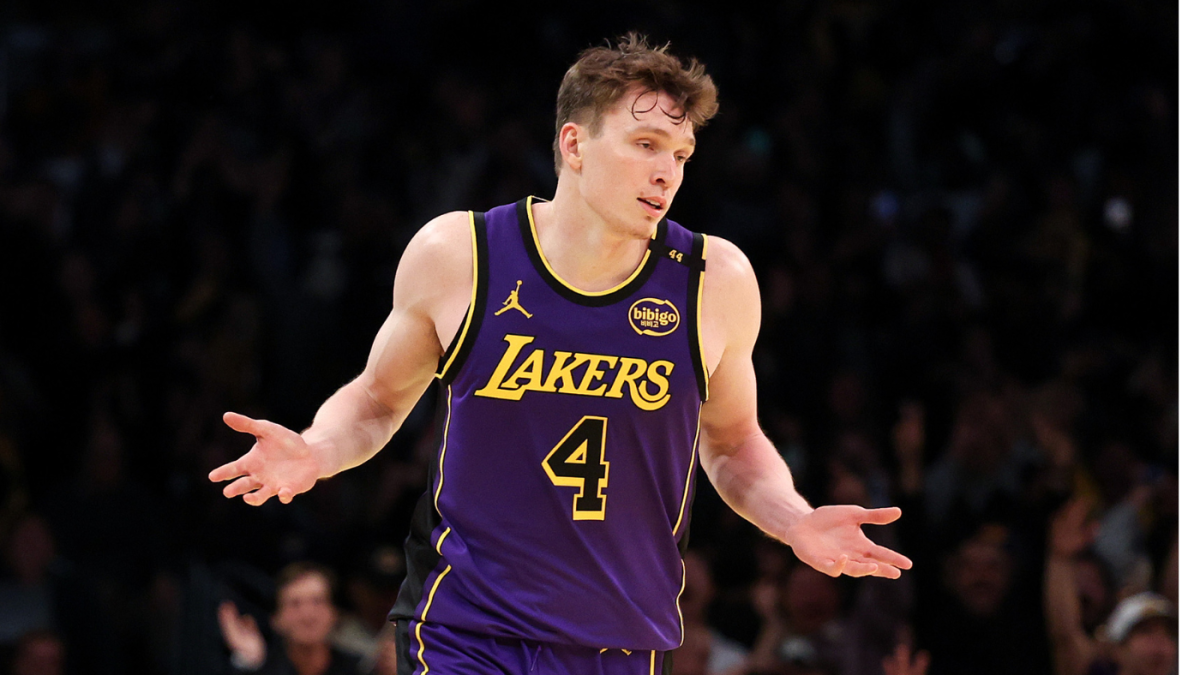It’s a commonly held belief in sports that a player shouldn’t lose his job due to injury. That is especially true of a short-term injury. Rui Hachimura has only missed a week, yet his sprained ankle may have just changed the entire outlook of the season for the Los Angeles Lakers. Why? Because for the past week, Dalton Knecht has looked like one of the very best shooters in all of basketball.
Across his last three starts, Knecht has now scored 88 points on 28-of-46 shooting from the floor and 16-of-26 shooting from deep. The No. 17 overall pick in June’s NBA Draft saved his best for last on Tuesday when, in a 124-118 victory over the Utah Jazz, he scored 37 points and tied the rookie record with nine 3-pointers in a single game. At one point in the second half, Knecht scored 22 consecutive Laker points.
It’s the sort of long-range explosion the Lakers have been lacking throughout the LeBron James-Anthony Davis era. This is a team that won a championship with a below-average half-court offense and took the third-fewest 3s in the NBA last season. Part of the logic behind hiring JJ Redick as head coach was that a formerly elite shooter from his playing days could help redesign the Laker offense to maximize spacing. Thus far this season, the Lakers have taken baby steps in the right direction. They’re up to 23rd in 3-point attempt rate from 28th a season ago, and landing Knecht is only pushing them further towards modernity.
When the Lakers landed Knecht at No. 17 overall, Redick reportedly started drawing up plays for him immediately on draft night. The trouble with doing so for a rookie in a bench role is that finding a rhythm in a low-usage role is extremely difficult. Knecht was used to being the focal point of his college offense at Tennessee, and he has been significantly more successful this season in games in which he’s played major minutes. He’s now played seven games in which he’s earned more than 20 minutes of playing time and 20 minutes in which he’s gotten less. When he’s played 20 or more minutes, he’s shooting 53.1% on 3s. When he’s played less? He’s at 31.6%.
Rhythm helps, but so too does fit. Shooters amplify the players around them, and are in turn amplified by their best teammates. It’s harder for defenses to direct appropriate resources towards Knecht when he’s sharing the floor with James and Davis, and slowing them down becomes significantly harder for them when they have to keep an eye on Knecht. Hachimura poses some of the same problems, but even as a high-percentage shooter, his volume remains fairly low. Hachimura’s value comes more out of his ability to use the threat of his jumper to create better looks for himself near the basket. That’s a skill that means more off the bench than it does with James, Davis and Austin Reaves on the court, as the Lakers have found since benching D’Angelo Russell.
The Lakers could play the two of them together, and almost certainly will in some alignments, but their perimeter defense leaves plenty to be desired even with Cam Reddish in a starting spot. Knecht, Hachimura and Reaves are all below-average defenders at best. Davis is one of the NBA’s best defenders, but asking him to cover all three of those liabilities invites foul trouble, exhaustion and potentially injury. Knecht and Hachimura might be the fourth- and fifth-best Lakers at the moment, but there’s really only space in the starting five for one of them.
And if their last three games have been any indication, Knecht is the easier fit, and he benefits far more from playing alongside the starters than Hachimura would. The Lakers have spent years searching for this sort of shooter. Now that they have him, it’s up to Redick to continue maximizing him with as many minutes and shot attempts as possible.

